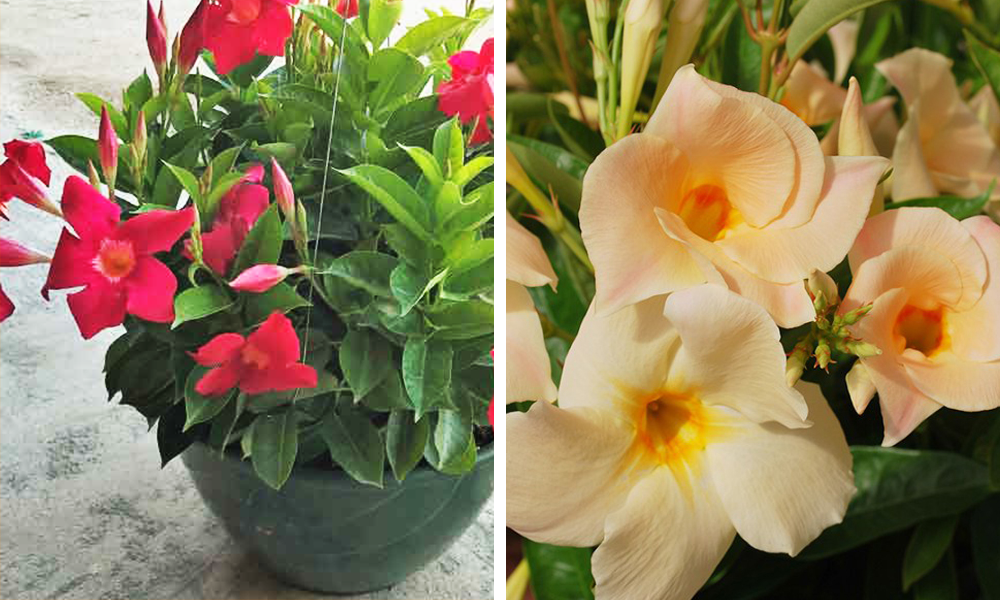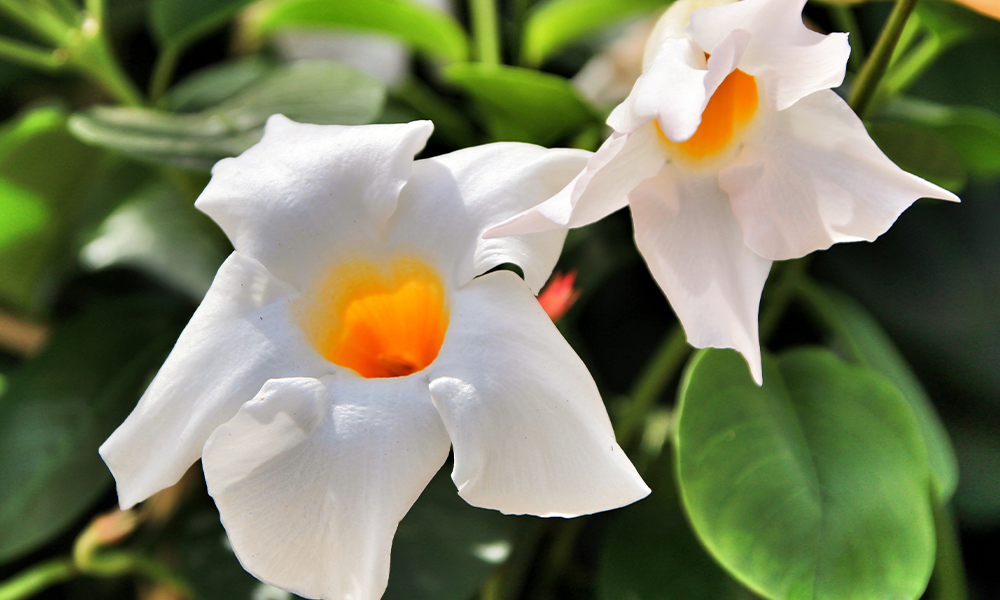Hanging baskets overflowing with bright flowers are a hallmark of our spring and summer gardens. You can bring that vibrancy and personality to your own home by adding some tropical flower hanging baskets to your front porch this season!
Mandevilla and Dipladenia are two of our favorite tropical bloomers for hanging baskets. Technically, they’re both members of the Mandevilla plant family, and they’re both commonly referred to as rocktrumpet. Despite these similarities, they are distinct in some ways. Dipladenia has smaller leaves that are heart-shaped and smooth and a more shrub-like growth habit. Dipladenias vine a little bit, but overall, they will maintain a shrub shape. Mandevilla, on the other hand, has larger long and narrow leaves and is a vigorous vining plant. It will grow up to 20’ long, filling a trellis or fence with its eye-popping trumpet-shaped flowers. Generally, Dipladenia flowers are also slightly smaller than those of the Mandevilla.
Dipladenia is an excellent choice for full, rounded hanging baskets, as it will fill the space and bloom all summer long if you keep it watered and fertilize it regularly.
Mandevilla is also an excellent option for hanging baskets, though it will likely climb up the hanger and trail down around the basket as well!
They both bloom profusely all summer long and have a delicious tropical scent that is reminiscent of Gardenia. Both Dipladenia and Mandevilla are available in a full range of pink shades, including bright white and deep crimson red, and they’re extremely popular with hummingbirds and butterflies.
History of Mandevilla
The Mandevilla family of plants is native to the Southwest US, Mexico, Central America, the West Indies, and South America. They’re commonly found in the forests around Rio de Janeiro, Brazil, where many varieties originate. They were named after the British diplomat, Henry Mandeville. Most modern hybrids were bred from 3 main varieties; M.xamabilis, M.splendens, and M.sanderi.
Care for Mandevilla & Dipladenia
The care requirements for Dipladenia and Mandevilla are the same. They both need excellent drainage and 6-8 hours of sunshine daily. They’ll likely do best in a south-facing location where they can soak up those rays as long as possible. Hanging baskets do tend to dry out rather quickly, so you’ll want to check if they need water every day, even on rainy days. Once their foliage fills out, it will block most rain from getting into the soil, so they may still need to be watered.
For the best blooms, it’s important to fertilize Mandevilla and Dipladenia regularly. You can mix a slow-release fertilizer into the soil when you plant them, or use a liquid bloom fertilizer mixed into some water every two weeks.

Favorite Tropical Bloomers
Our white Dipladenia features bright white petals with deep yellow throats. The contrast against the dark green foliage is classically beautiful. The white blossoms seem to practically glow in the evenings after the sun has gone down. White Mandevilla is similar but features paler yellow centers and darker green leaves.
The apricot Mandevilla is a delicate peach shade that shows slight variations from pink to orange and yellow. The throat of the flowers features alternating stripes of pretty yellow and orange.
Striking red Dipladenia features deep crimson red blossoms with bright yellow throats. The colors are spectacular.
Add a few gorgeous tropical Mandevilla or Dipladenia hanging baskets to your home today for summer-long flowers and beautiful fragrance!


